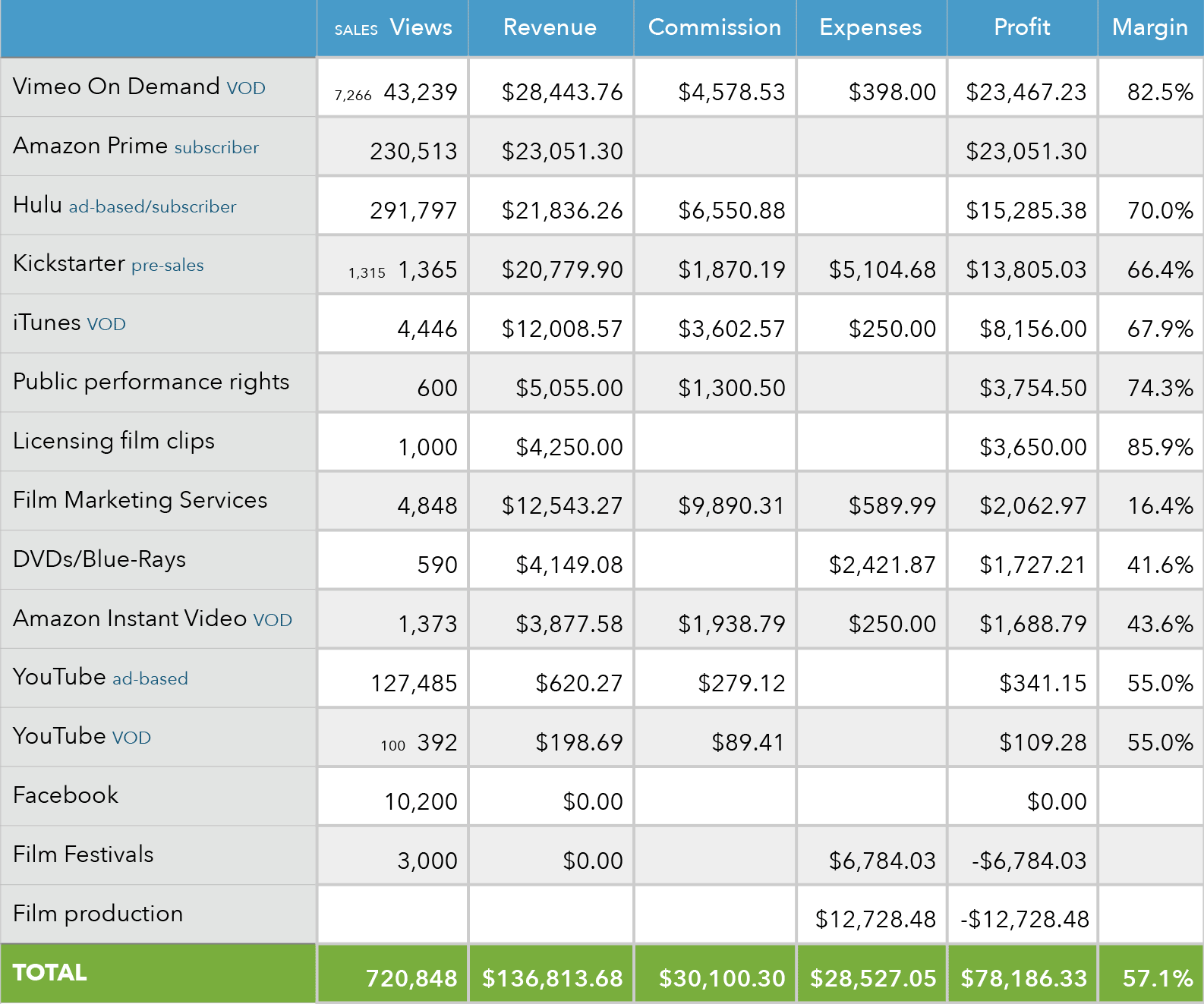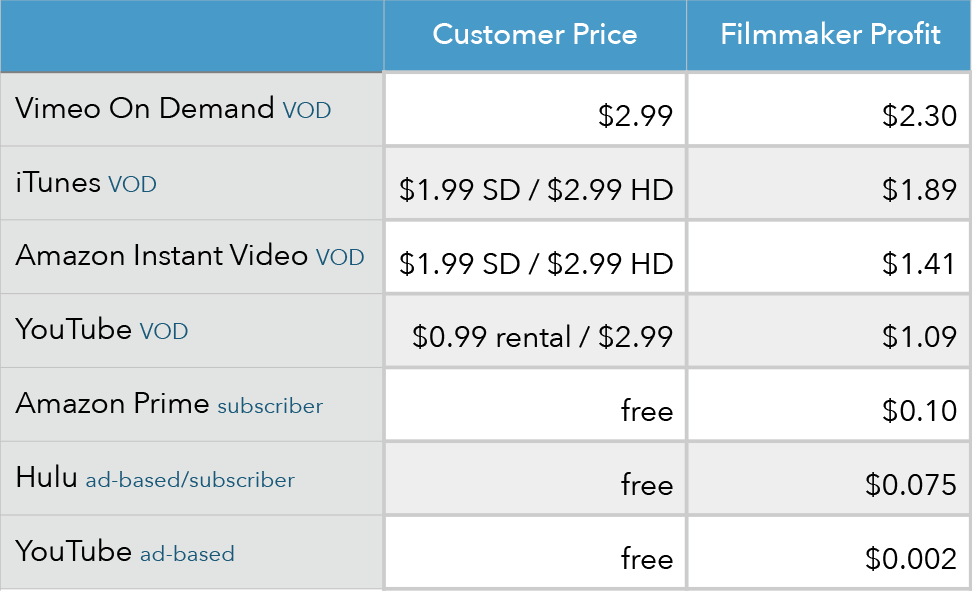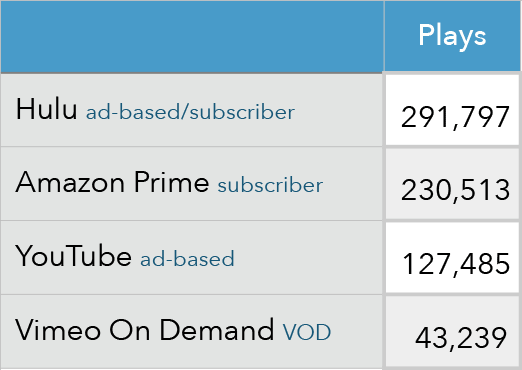
Sold-out crowd for “Sriracha” at the Roxie Theatre, San Francisco. April 3, 2014
By Griffin Hammond (https://medium.com/@GriffinHammond/5-lessons-learned-from-my-profitable-indie-documentary-2017-update-fd8ded8be493)
- A little over three years ago, I released a 33-minute indie documentary called Sriracha—about the iconic hot sauce.
- 20 months ago, I revealed my revenue numbers in a popular blog post.
- Today, I’ve learned a few new lessons, and have fresh data to share.
The goal in producing the film wasn’t to make money, but after spending $12,728 on production three years ago, the film has generated $136,813 in revenue, from 720,848 views.
First 36 months of revenue (through December 2016)

1. Vimeo is still the best profit margin.
I
lose a 10–50% commission per sale, depending on the video platform.
That’s $30,100 in fees that’s gone directly to iTunes, Amazon, YouTube,
etc—money I never see.
I’ve
paid an average 22% to commissions, yet Vimeo takes only a 10% cut—the
best profit margin in the industry. That, plus nice video quality and
features, is why I chose to premiere Sriracha in 2013 on Vimeo On Demand.
At
my current $2.99 price point, I lose $0.30 to Vimeo, plus some tax and a
PayPal processing fee. On average, I receive $2.30 per sale.

Vimeo On Demand requires an additional cost—$199 annually for the Vimeo Pro membership,* which has worked out to $0.05 per sale.
7,266 sales through Vimeo have generated $28,443 in revenue, which is $23,467 to me—a profit margin of 82.5%.
*Vimeo covered my first year, for being an early adopter. You can save $50 off Vimeo Pro through this link.
Fun
facts: 259,517 Vimeo trailer plays have led to 7,266 sales, a 2.8%
conversion rate. The average purchaser watches several times; the film’s
been viewed 43,239 times on Vimeo. 60% of sales are in the U.S.
Embedding the film’s trailer via Vimeo includes a useful Purchase link.
2. Over 500,000 views from Hulu and Amazon!
On video-on-demand (VOD) platforms, I receive at least $1.09 per sale (chart above). But the film is free for Amazon Prime subscribers, where it only earns $0.10 per view. On ad-supported Hulu,* it’s only $0.075 per view.
So
naturally, I feared these free platforms would kill VOD sales and
devalue my film. But although 10 cents sounds insulting, Amazon Prime
and Hulu have delivered an incredible volume—522,310 views collectively.
That’s 72% of the Sriracha audience to date. So
even though I’m paid less than 1/20th what Vimeo shares per sale,
Amazon Prime and Hulu are responsible for a full one-third of the film’s
revenue—$44,887. And they’re on pace to each surpass my Vimeo revenue soon.
*Note: Weirdly, Hulu appears to have removed Sriracha recently.

The one free platform that hasn’t performed well is ad-based YouTube. I happily published a free director’s commentary version, but it’s not a viable money maker for indie films. I’ve been paid $341 for 127,485 views — only $0.002 per view.
My director’s commentary on YouTube has only generated $0.002 per view.
3. My release strategy was accidentally great.
Some sales have fallen significantly after the 2013 release: On Vimeo, Sriracha made $19,566 in 2014, $3,051 in 2015, and $1,247 in 2016.
But because Sriracha didn’t land on Amazon Prime
until mid-2015, revenue peaked in the film’s second year, and 2016
actually earned slightly more than in 2014. In the first 18 months,
301,603 people watched Sriracha. But that grew to 720,848 by 36 months.
I’d
expected sales to fall to near zero after the initial publicity, so
I’ve been amazed at this “long tail” on sales. I credit this to a
marketing strategy called windowing—which I stumbled into unintentionally.
As
a one-man-band filmmaker, I also did most of my own distribution,
marketing and public relations, which meant I simply didn’t have the
bandwidth to premiere my film across all platforms at once.
Besides, Amazon and iTunes don’t let indie filmmakers publish directly. I had to pay an aggregator (I chose Premiere Digital)
a one-time $500 ingestion fee to land the film on iTunes and Amazon
Instant Video. After that initial fee, Premiere Digital does not take a
per-sale commission.
Not with any particular strategy in mind, here’s how I rolled out Sriracha:
- December 11, 2013:
Sriracha premiered on Vimeo On Demand. - August 29, 2014:
Aggregator Premiere Digital published to iTunes and Amazon Instant Video ($1.99 SD / $2.99 HD). - September 2, 2014:
Distributor Janson Media published to Hulu (free, ad-based/subscriber). - April 17, 2015:
I asked Premiere Digital to turn on Amazon Prime (free for subscribers). - April 18, 2016:
In addition to my free director’s commentary version on YouTube, I added a paid YouTube option. ($0.99 HD rental / $2.99 HD)
It turns out this strategy of premiering a film at separate times on separate platforms is called windowing. Each premiere is a new opportunity for excitement, a new likelihood of press coverage, a chance to reach new viewers. Each platform will treat the film as new, often featuring it prominently in the user interface.
And
each new platform premiere has helped other platforms. Sales on Vimeo
increased with the iTunes premiere. Sales on Amazon Instant Video jumped
when the film became popular among Amazon Prime subscribers.
Though I realize future films of mine may not perform as well or even be appropriate for VOD, the longevity of Sriracha
is striking. What if I made several films like this? Or a large
catalogue of films and tutorials, each generating revenue in diverse
ways over many years? Theoretically there’s a point at which your body
of work collectively pays a living wage.
4. Beware shady distribution companies.
In addition to these self-distribution avenues, Sriracha is represented by two distributors. One I like: Janson Media—which takes a 30% fee—has licensed the film to Hulu, public performances, and in-flight entertainment.
But the experience with my other distributor—who no longer speaks to me—has not been positive.
Peter Greene and Jon Gursha of Film Marketing Services (Marina Del Ray, CA) offered their services four months after I released Sriracha (April 2014). In addition to a 20% commission, they asked for a $500 fee to cover the upfront costs of selling my film.
In July 2014, they arranged a deal to air Sriracha on the cable network Shorts International, but long after I’d sent the broadcast video file to Shorts, Film Marketing Services never shared the terms of deal, or whether it had been executed.
Likewise, after they published the film to Hoopla—a
platform that sells DVDs and digital copies to libraries—in June 2015,
Film Marketing Services never told me whether the film had made any
money.
Yet in August 2015, I saw this Film Marketing Services tweet:
Client Sriracha #1 on #Hoopla
For Sriracha to
be #1 on this sales channel, I figured it must have made at least one
dollar. But between e-mail and phone tag, it took another nine months
for Peter and Jon to say the film had generated sales. In May 2016, I
received my first payment—$1,046.26.
But
by then, I had raw revenue data from Hoopla, which showed Film
Marketing Services had received $6303.73 in payments. My math said the
payment should have been $5042.98, after their 20% commission.
Their
math was convoluted, never consistently calculated, included duplicate
fees that Hoopla had already subtracted, and always diminished my share
far below my interpretation of our contract.
So
far, I’ve received $2,062.97 from Film Marketing Services, and can only
estimate the revenue they’ve generated, as they haven’t told me.
Including the Shorts International contract, I estimate Sriracha has earned $12,543.27 for Film Marketing Services.
Peter Greene and Jon Gursha—who also operate Silicon Beach Distribution, the Silicon Beach Film Festival, Culver City Film Festival, and Marina Del Rey Film Festival—have cut off communication, and will not compel Shorts International to share the terms of their Sriracha licensing deal.
5. I made money, because I wasn’t trying to make money.
I’m convinced that Sriracha
has only been profitable because profit wasn’t my goal. I set out to
make a film because I was personally curious about the story, and
because I wanted this film to exist. For me, for my reel, for any audiences who might want to watch something I would want to see.
Author Neil Gaiman put it well: “If I did work I was proud of, and I didn’t get the money, at least I’d have the work.”
“The things I did because I was excited, and wanted to see them exist in reality have never let me down, and I’ve never regretted the time I spent on any of them.”—Neil Gaiman
I’m proud and fortunate that Sriracha
has turned a profit of $78,186 in its first 36 months—especially when
indie films notoriously struggle to break even. But while this
additional income makes my finances easier, it’s been the opportunities
that have come from this film existing that are the real return on investment.
Sriracha is what got me hired by Bloomberg TV in 2014 to cover the U.S. presidential election. It’s what landed me on the 2017 American Film Showcase roster—sending me to Bahrain and Israel. It’s partly why Panasonic appointed me global brand ambassador for their new GH5 camera.
This film has become my calling card, and I know it will continue to
lead me to interesting opportunities. If I could only have one—the film
or the money—I’d turn down the money.
No comments:
Post a Comment